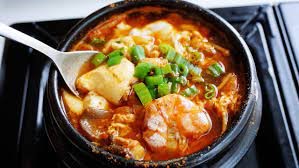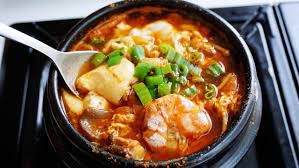Korean cuisine is known for its rich flavors, unique ingredients, and diverse array of dishes that delight the taste buds. One such dish that has gained international recognition for its comforting warmth and deliciousness is Sundubu Jjigae (순두부찌개). This Korean stew, featuring soft tofu and an assortment of ingredients, has a fascinating history and offers numerous health benefits. In this comprehensive blog post, we will delve into the world of Sundubu Jjigae, exploring its origins, various types, nutritional value, storage methods, recipes, and much more.
The History of Sundubu Jjigae (순두부찌개)
Sundubu Jjigae has a long and storied history that dates back to ancient Korea. The name “Sundubu” refers to the soft, silky tofu used in the dish, while “Jjigae” means stew. This combination of ingredients and cooking style has been a beloved staple of Korean cuisine for centuries.
Ancient Origins: While the exact origin of Sundubu Jjigae is unclear, tofu itself has a long history in Korea. Tofu-making techniques were introduced to Korea from China around the 14th century, during the Goryeo Dynasty. The availability of tofu led to the development of various tofu-based dishes, including Sundubu Jjigae.
Evolution over Time: Sundubu Jjigae has evolved over the years, adapting to regional preferences and ingredient availability. It is now enjoyed in countless variations, each with its unique twist.

Various Types of Sundubu Jjigae
Sundubu Jjigae is a versatile dish, and it can be customized to suit different tastes and dietary preferences. Here are some popular variations:
- Seafood Sundubu Jjigae: This version includes an assortment of seafood such as shrimp, clams, and squid, which adds a delightful oceanic flavor to the stew.
- Kimchi Sundubu Jjigae: Kimchi lovers rejoice! Kimchi Sundubu Jjigae incorporates the iconic Korean fermented cabbage for a spicy and tangy kick.
- Mushroom Sundubu Jjigae: Ideal for vegetarians, this version features an array of mushrooms like shiitake, oyster, and enoki, creating a rich, earthy flavor.
- Beef Sundubu Jjigae: For those who prefer meat in their stew, thinly sliced beef is added, infusing the dish with savory goodness.
- Spicy Sundubu Jjigae: If you like your food with a kick, the spicy Sundubu Jjigae, often referred to as “Yukgaejang,” is perfect. It’s made spicy with the addition of gochugaru (Korean red pepper flakes).
Must Read: Popular Chinese Dishes
Benefits of Sundubu Jjigae (순두부찌개)
Sundubu Jjigae isn’t just delicious; it also offers numerous health benefits:
- Rich in Protein: The tofu in Sundubu Jjigae is an excellent source of plant-based protein, making it a favorite among vegetarians and vegans.
- Low in Calories: Sundubu Jjigae is relatively low in calories, making it a great option for those looking to manage their weight.
- Abundance of Vitamins and Minerals: This dish is packed with essential nutrients like calcium, iron, and magnesium, thanks to the tofu and various vegetables used.
- Digestive Health: The kimchi used in some variations contains probiotics that are beneficial for gut health.
- Spice for Metabolism: Spicy versions of Sundubu Jjigae can boost metabolism due to the presence of capsaicin in red pepper flakes.
How to Store Sundubu Jjigae (순두부찌개)
If you have leftovers or wish to prepare Sundubu Jjigae in advance, here’s how to store it properly:
- Refrigeration: Transfer the stew into an airtight container and store it in the refrigerator for up to 3 days. Be sure to cool it down to room temperature before refrigerating.
- Freezing: You can freeze Sundubu Jjigae for longer-term storage. Place it in a freezer-safe container and leave some space for expansion. It can be stored in the freezer for up to 3 months.
- Reheating: When ready to eat, gently reheat the stew on the stove or in the microwave. Be cautious not to overcook it, as tofu can become mushy when reheated excessively.
Must Read: Italian Seafood Dishes
Recipes of Sundubu Jjigae (순두부찌개)
Now, let’s explore how to make a classic Sundubu Jjigae:
Classic Sundubu Jjigae Recipe
Ingredients:
- 1 package of soft tofu (sundubu)
- 1/2 onion, thinly sliced
- 1/2 zucchini, thinly sliced
- 1/2 carrot, thinly sliced
- 2-3 cloves garlic, minced
- 1 green onion, chopped
- 1/2 cup of kimchi (optional for a spicy version)
- 1/2 cup of sliced mushrooms (e.g., shiitake)
- 1/2 cup of seafood (shrimp, clams, or squid)
- 1 tablespoon soy sauce
- 1 tablespoon gochugaru (Korean red pepper flakes, adjust to taste)
- 2 cups of vegetable or seafood broth
- Salt and pepper to taste
- 1 tablespoon sesame oil
- 1 egg (optional)
Instructions:
- Heat sesame oil in a pot over medium heat.
- Add minced garlic, sliced onions, carrots, and zucchini. Sauté until they start to soften.
- If you’re making a spicy version, add kimchi and gochugaru. Sauté for an additional minute.
- Pour in the broth and bring it to a boil.
- Carefully add the tofu, breaking it gently into chunks.
- Add seafood, mushrooms, and soy sauce. Simmer for about 5-7 minutes.
- Season with salt and pepper to taste.
- If desired, crack an egg into the stew and let it poach until the white is set but the yolk is still runny.
- Garnish with green onions and serve hot with steamed rice.
What to Do with Sundubu Jjigae (순두부찌개)
Sundubu Jjigae is a complete meal in itself, but you can enhance your dining experience by pairing it with:
- Steamed Rice: The most common accompaniment to Sundubu Jjigae is a bowl of hot, steamed rice. The rice helps balance the spiciness and adds substance to the meal.
- Banchan (Side Dishes): Complement your Sundubu Jjigae with an array of Korean side dishes like kimchi, pickled vegetables, or seasoned seaweed.
- Sesame Leaves: Wrapping a spoonful of Sundubu Jjigae in fresh sesame leaves is a delightful way to enjoy the stew.
Must Read: Popular Italian Dishes
What to Cook with Sundubu Jjigae
Sundubu Jjigae is a versatile dish that can be incorporated into various meals:
- Bibimbap: Use leftover Sundubu Jjigae as a topping for bibimbap, a popular Korean mixed rice dish.
- Noodles: Transform it into a noodle soup by adding cooked Korean glass noodles (dangmyeon) or udon noodles.
- Stir-Fry: Create a Sundubu Jjigae stir-fry by sautéing the ingredients with rice or noodles in a pan.
How to Make Sundubu Jjigae
Making Sundubu Jjigae at home is relatively easy, but it requires some essential ingredients and attention to detail. Here’s a step-by-step guide to crafting this delightful dish:
- Gather all the necessary ingredients.
- Prepare the vegetables by slicing them thinly.
- Heat sesame oil in a pot and sauté garlic and onions until fragrant.
- Add the broth and bring it to a boil.
- Carefully add the tofu, breaking it into chunks.
- Include your choice of protein, such as seafood or meat.
- Season the stew with soy sauce, gochugaru (for spiciness), and salt and pepper to taste.
- Let the stew simmer until the ingredients are cooked through.
- If desired, poach an egg in the stew.
- Garnish with chopped green onions and serve hot with steamed rice.
See Also: Dishes that can be made using Leftover Food
Sundubu Jjigae Ingredients
- Soft tofu (sundubu)
- Onion
- Zucchini
- Carrot
- Garlic
- Green onion
- Kimchi (optional)
- Sliced mushrooms (e.g., shiitake)
- Seafood (shrimp, clams, squid, etc.)
- Soy sauce
- Gochugaru (Korean red pepper flakes)
- Vegetable or seafood broth
- Salt
- Pepper
- Sesame oil
- Egg (optional)
Nutrition in Sundubu Jjigae
The nutritional content of Sundubu Jjigae varies depending on the specific ingredients used. However, here is a general overview of the key nutrients you can find in a typical serving:
- Calories: Approximately 200-300 calories per serving.
- Protein: 10-15 grams, mainly from tofu and seafood/meat.
- Carbohydrates: 10-15 grams, primarily from tofu and vegetables.
- Fiber: 2-4 grams, depending on the amount of vegetables used.
- Vitamins and Minerals: Sundubu Jjigae is rich in calcium, iron, magnesium, and vitamins like vitamin C and vitamin K.
- Healthy Fats: Sesame oil adds healthy fats to the dish.
- Probiotics (if kimchi is included): Beneficial for gut health.
Must Read: Spicy soft tofu stew with kimchi and pork belly
FAQs
1. Is Sundubu Jjigae vegan-friendly?
- Yes, Sundubu Jjigae can be made vegan by omitting seafood or meat and using vegetable broth.
2. Can I use firm tofu instead of soft tofu?
- While soft tofu is traditional for Sundubu Jjigae, you can use firm tofu if you prefer a different texture.
3. How spicy is Sundubu Jjigae?
- The spiciness of Sundubu Jjigae can vary. You can adjust the level of spiciness by adding more or less gochugaru.
4. Can I make Sundubu Jjigae without kimchi?
- Yes, you can make a non-spicy version without kimchi. It will still be delicious and flavorful.
5. Can I use chicken or pork instead of seafood?
- Absolutely! Sundubu Jjigae is versatile, and you can customize it with your choice of protein.
Conclusion
Sundubu Jjigae (순두부찌개) is a beloved Korean stew that has captivated palates worldwide with its rich history, flavorful variations, and health benefits. Whether you prefer it spicy, with seafood, or in its classic form, this dish offers a comforting and satisfying dining experience. Armed with this guide, you can now explore the world of Sundubu Jjigae, from its origins in ancient Korea to the kitchen in your own home. So go ahead, embrace the warmth and flavors of Sundubu Jjigae, and discover why it has earned its place as a cherished gem in Korean cuisine.
Recommended: 10 Great Korean Dishes

